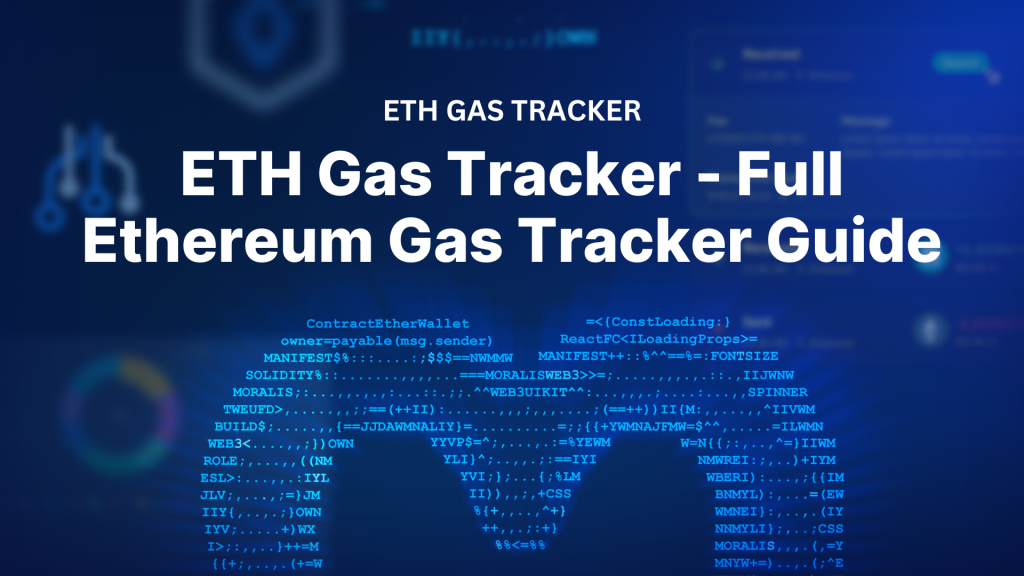
When interacting with the Ethereum blockchain, you’re required to pay gas fees. These fees are known for being volatile, and the price is directly influenced by the network’s supply and demand of computational power. Consequently, during times of high network activity, it can be quite expensive to transact on the Ethereum blockchain. Fortunately, this is where tools like Ethereum gas trackers enter the equation, allowing crypto enthusiasts, traders, and Web3 developers to optimize transactions for cost-effectiveness and performance. But what exactly is an ETH gas tracker? And where can you find the best one? If you’re looking for the answers to these queries, follow along in this article as we explore the intricacies of ETH gas trackers!
Overview
In today’s guide, we’ll kick things off by diving into the intricacies of Ethereum gas trackers. In doing so, we’ll learn what they are, how they work, and why you might need them. From there, we’re going to dive straight into our ETH gas tracker list, where we’ll cover three prominent platforms: Etherscan, Blocknative Gas Estimator, and Cryptocurrency Alerting. Lastly, for those interested in Web3 development, we’ll top things off by introducing you to Moralis – the industry’s #1 tool for anyone looking to build blockchain analytics platforms and other Web3 projects!
In Moralis’ suite of Web3 APIs, you’ll find multiple interfaces for various use cases. And a great example is the ETH API – the ultimate tool for Ethereum development. As such, when working with Moralis, you can build decentralized applications (dapps) and other blockchain-based platforms without breaking a sweat.

Also, did you know you can access all our premier Web3 APIs for free? Simply sign up with Moralis and start optimizing your Web3 development endeavors today!
Nevertheless, without further ado, let’s dive straight into the main topic and answer the question, ”What is an ETH gas tracker?”
What is an ETH Gas Tracker?
Gas fees on Ethereum are known for being notoriously volatile, which is a direct effect of the dynamic interplay between supply and demand for processing power within the network. Consequently, when Ethereum is experiencing high activity, the demand for processing power exceeds supply, causing prices to surge. This has been a recurring issue on Ethereum, where the network has experienced astronomically high gas fees, rendering it economically unviable for many users to transact on the blockchain.
So, how do users deal with these issues? And how are they mitigating gas fees on Ethereum?
Well, this is where ETH gas trackers enter the equation!
Put simply, an ETH gas tracker is an application, website, or other platform monitoring and providing information about historical and current gas fees on the Ethereum network. With greater insight into the gas dynamics of Ethereum, users can leverage this data to make more informed decisions on when and how to carry out transactions. In return, this allows them to optimize the cost-effectiveness and performance of their Ethereum transactions!
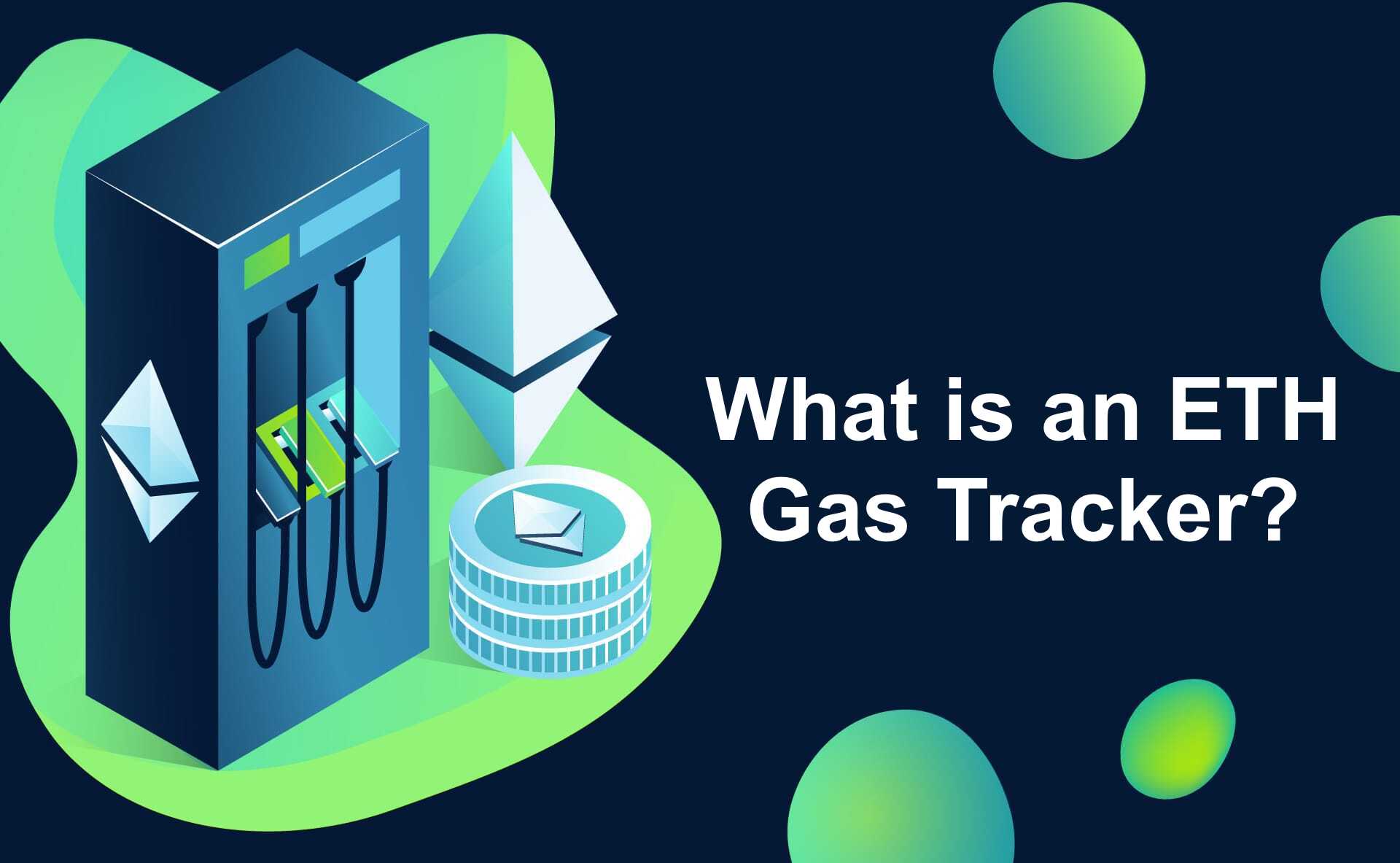
Nevertheless, to better understand ETH gas trackers and the utility of these tools, let’s take the following subsection to dive a bit deeper into gas fees on the Ethereum network!
Gas Fees on Ethereum
In the context of Ethereum, gas refers to the unit that measures the computational efforts required to execute certain operations on the Ethereum network. In short, it’s essentially the fuel that powers the network, much in the same way that a car relies on gasoline to run!
With that said, what exactly are Ethereum gas fees?
Well, gas fees on Ethereum are made up of three distinct components:
- Base Fee: The base fee is set by the protocol, and it’s the least amount you must pay for your transactions to be considered valid.
- Priority Fee: The priority fee is a tip that you add on top of the base fee, making it more attractive to validators so they choose it for inclusion in the next block.
- Units of Gas Used: More complex operations require more computational power. For instance, interacting with smart contracts uses more gas than sending simple transactions.
What’s more, the formula for calculating Ethereum gas fees is: Units of gas * (base fee + priority fee).
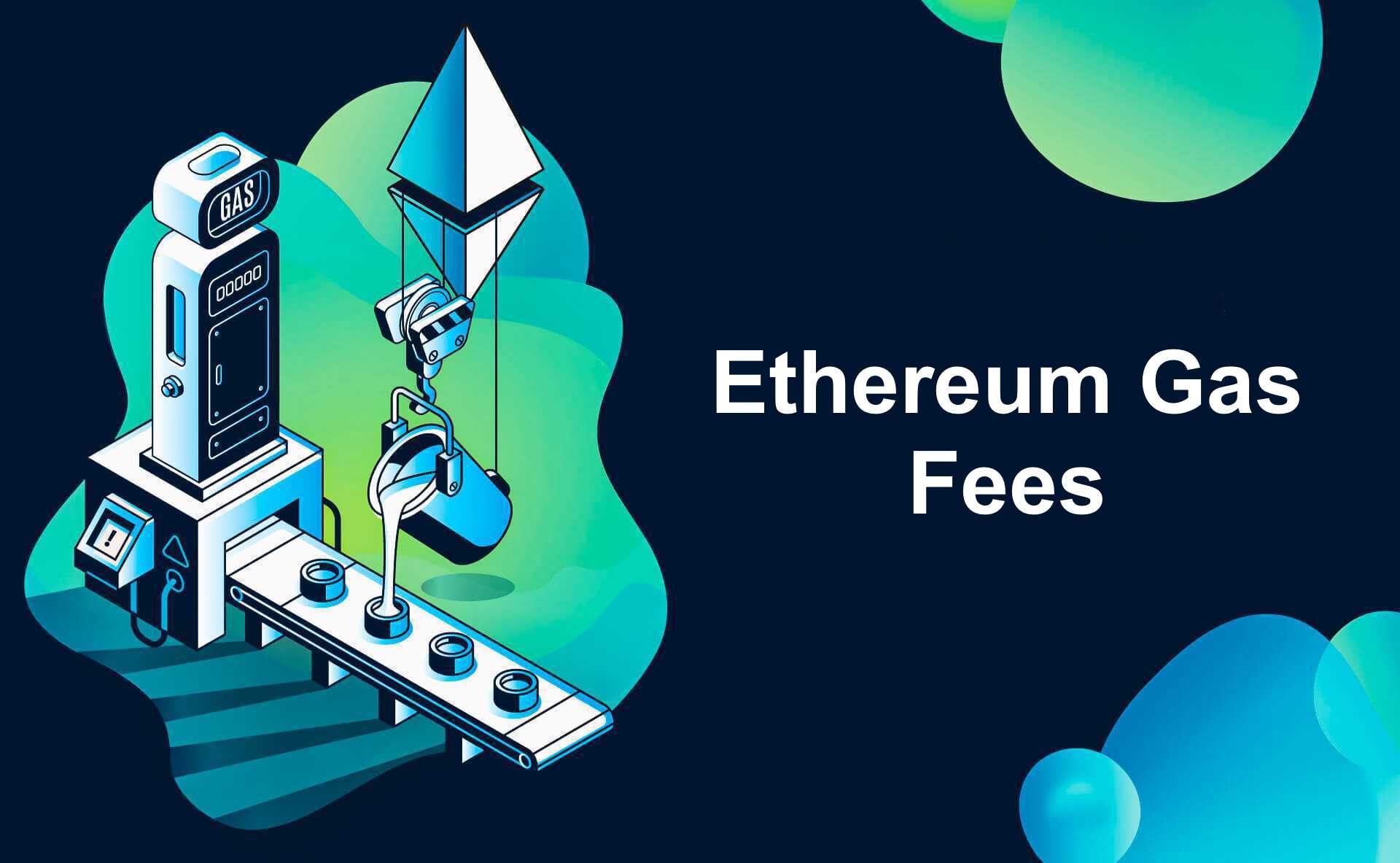
Moreover, gas fees on Ethereum have to be paid in the chain’s native cryptocurrency, Ether (ETH). However, prices are typically denominated in Gwei – short for gigawei – which equals one billionth of an ETH (0.000000001 ETH).
All in all, gas fees are what users pay to process transactions or smart contracts on the Ethereum blockchain. What’s more, these fees can change drastically in a short period depending on supply and demand factors. And one of the easiest ways to monitor and understand Ethereum gas fees is to use a tool like an ETH gas tracker!
Now, with an overview of Ethereum gas fees, let’s dive into our ETH gas tracker list to explore some existing platforms you can use!
ETH Gas Tracker List
There are multiple prominent ETH gas trackers available on the market for you to choose from, and we won’t be able to cover them all in this article. Consequently, in the following sections, we have put together an ETH gas tracker list comprising three industry-leading platforms:
- Etherscan
- Blocknative Gas Estimator
- Cryptocurrency Alerting
However, the ETH gas trackers above are only three prominent examples. If you’d like to explore more platforms, check out our Web3 gas tools page on Moralis’ dapp store: Web3 Wiki!
Nevertheless, without further ado, let’s dive straight into our first ETH gas tracker: Etherscan!
Etherscan
Etherscan is a popular blockchain explorer and analytics platform that tracks and sorts data from the Ethereum blockchain into easily navigatable information. With Etherescan, it’s possible to seamlessly look through blocks, transactions, smart contracts, wallet addresses, and other on-chain-related data on the Ethereum network. Furthermore, one of Etherscan’s most prominent features includes the ETH gas tracker!
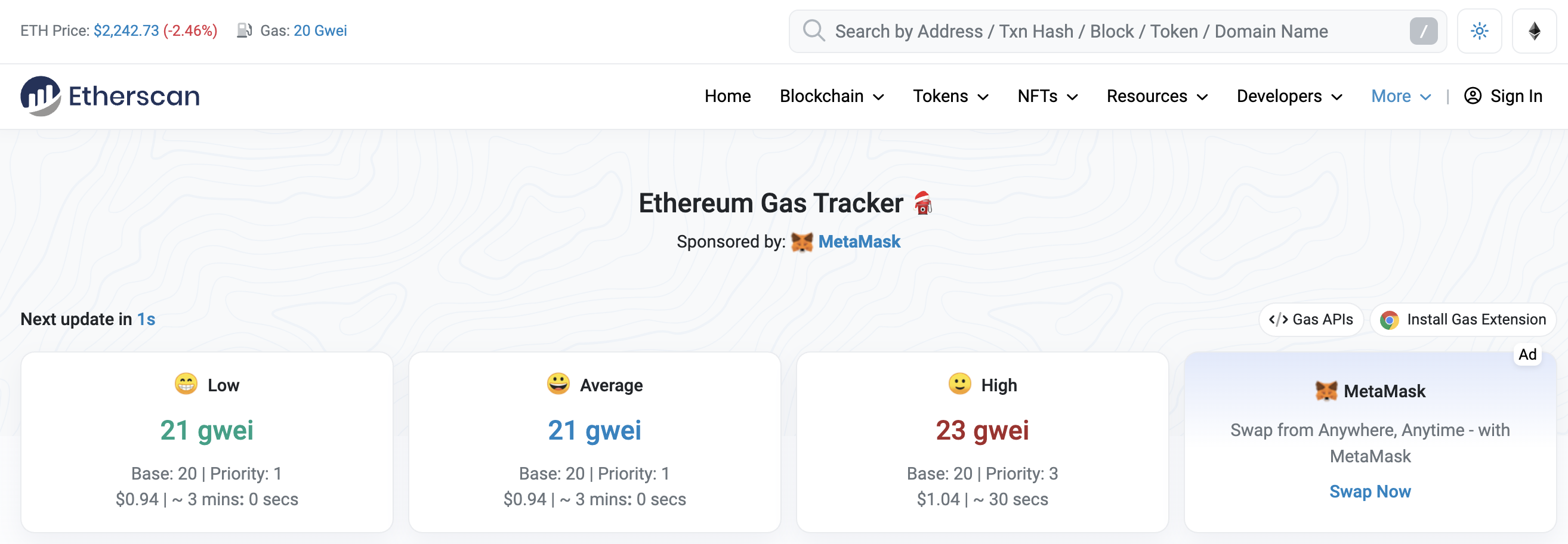
Etherescan’s ETH gas tracker is one of the most popular tools for tracking Ethereum gas prices. With it, you can effortlessly access both real-time and historical ETH gas prices so you can make well-informed decisions on when and how to transact on the network.
Moreover, Etherescan’s ETH gas tracker updates gas estimations every 15 seconds and provides features like a gas price heatmap, historical charts, and price estimates for various actions, such as swapping fungible tokens, NFT sales, and much more.
Blocknative Gas Estimator
Blocknative Gas Estimator is another prominent ETH gas tracker. This tool inspects all pending public Ethereum transactions, and leverages advanced machine-learning models to deliver accurate gas fee predictions. What’s more, Blocknative Gas Estimator offers free updates every five seconds. And commercial users can even get updated gas fee estimations once every second!
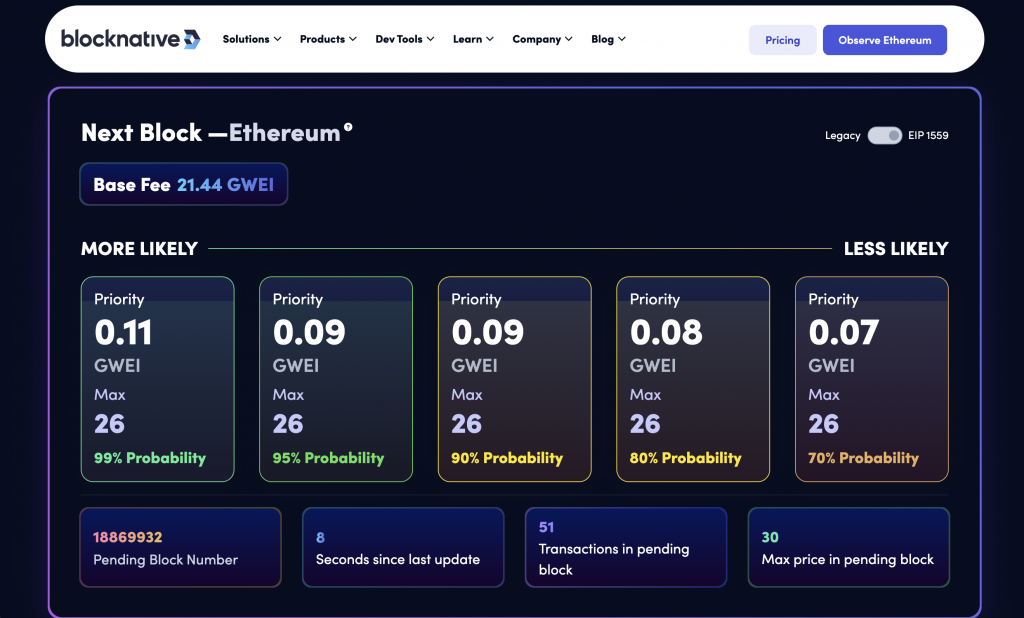
Furthermore, like Etherscan, Blocknative Gas Estimator also provides additional features, including historical heatmaps and charts for gas fees. With this information, you can effortlessly look at past data to determine the best time to transact on the Ethereum network. And in doing so, it’s possible to optimize for cost-effectiveness and performance.
Moreover, Blocknative Gas Estimator is also available as a browser extension for Chrome, Firefox, and Brave.
Cryptocurrency Alerting
Cryptocurrency Alerting is a reliable alert service for crypto enthusiasts, traders, and Web3 developers. With this tool, it’s possible to set up alerts to track the fluctuations in Ethereum gas fees. In doing so, you can seamlessly avoid transacting on Ethereum when network activity is high and take advantage of the low gas fee periods!
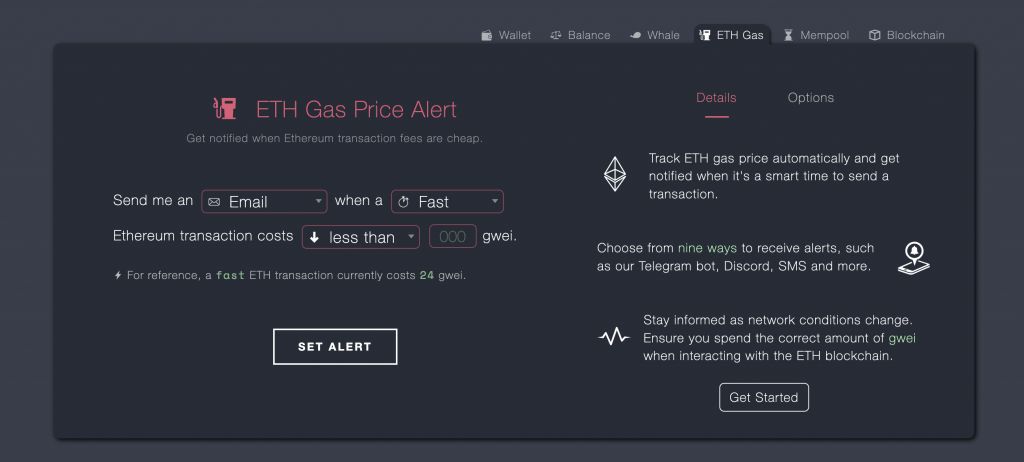
Moreover, Cryptocurrency Alerting sources real-time data from almost 50 cryptocurrency exchanges to represent gas fees accurately. Also, the alert system supports up to nine different platforms, including Slack, Telegram, email, SMS, etc.
All in all, with Cryptocurrency Alerting, you can effortlessly track Ethereum gas prices even when you aren’t in front of your screen to catch the best time to transact on the network!
Now, with an overview of ETH gas trackers, we’ll take the remaining part of the article to introduce you to Moralis – the ultimate tool for anyone looking to build blockchain analytics platforms!
Introducing Moralis: Easiest Way to Build Blockchain Analytics Platforms
Moralis is the industry’s premier Web3 API provider, and with our leading interfaces, you can effortlessly save both valuable time and resources in your development endeavors!

Moralis’ suite of Web3 APIs contains a bunch of interfaces for various use cases. Consequently, when working with Moralis, you can seamlessly build everything from decentralized exchanges (DEXs) to advanced blockchain analytics platforms.
So, why should you be leveraging Moralis when building Web3 projects?
To answer the above query, let’s explore three benefits of Moralis:
- Top Performance: Moralis’ Web3 APIs offer top performance. And it doesn’t matter if you want to measure by reliability, speed, or any other metric; Moralis always comes out on top compared to the competition.
- Cross-Chain Compatability: Our APIs are chain agnostic, supporting networks like Ethereum, BNB Smart Chain (BSC), Polygon, Arbitrum, Gnosis, and many others. Consequently, when working with Moralis, it has never been easier to build cross-chain compatible dapps.
- Trusted By Industry Leaders: Moralis’ APIs are trusted by industry leaders, including MetaMask, Polygon, Opera, Delta, and many others!

Now, with an overview of why you should leverage Moralis’ industry-leading interfaces, let’s take the following section to briefly introduce our various APIs!
Exploring Moralis’ Web3 APIs
In Moralis’ suite of premier Web3 APIs, you’ll find 10+ industry-leading interfaces. And we won’t be able to cover them all in this section. Instead, we’ll focus on five prominent examples:
- Blockchain API: With the Blockchain API, you can effortlessly unlock the power of raw and decoded blockchain data with pace and precision. With only single lines of code, you can use this tool to get block metrics, smart contract logs, events, and more.
- Wallet API: Moralis’ Wallet API is the ultimate tool if you’re looking to integrate wallet functionality into your Web3 projects. You can use this interface to effortlessly get wallet balances, transactions, transfers, etc.
- NFT API: The NFT API is the ultimate tool for NFT data. And it supports 3+ million NFT collections across 10+ EVM chains. This includes everything from established projects like CryptoPunks to tokens that dropped just seconds ago. Use this interface to get NFT metadata, transactions, price data, and much more.
- Token API: The Token API allows you to effortlessly fetch and integrate real-time ERC-20 token prices, transfers, wallet balances, and more into your Web3 projects with only single lines of code. As such, with this interface, you can build everything from your own crypto wallets to DEXs.
- Streams API: Moralis’ Streams API allows you to set up streams to get notifications about real-time Web3 events sent directly to the backend of your projects via webhooks. As such, with this tool, you can effortlessly build dapps – such as an on-chain wallet tracker – that rely on real-time updates.

Nevertheless, that gives you a brief overview of five prominent interfaces. If you’d like to explore them all in further detail, check out our Web3 API page!
Summary: What is an ETH Gas Tracker?
In today’s article, we dove into the ins and outs of ETH gas trackers. In doing so, we learned that they are platforms allowing users to find the optimal time to transact on Ethereum.
From there, we jumped straight into an ETH gas tracker list, where we looked closer at three prominent platforms:
- Etherscan
- Blocknative Gas Estimator
- Cryptocurrency Alerting
As such, if you have followed along this far, you now know what an Ethereum gas tracker is and where you can find the best one!
Lastly, to top things off, we also briefly introduced you to Moralis’ industry-leading suite of Web3 APIs. With tools like the Blockchain API, Wallet API, etc., you can start to build blockchain-based projects faster and more efficiently.

If you liked this ETH gas tracker article, consider checking out more content here on the blog. For instance, dive into the intricacies of the data availability layer in crypto or learn how to watch on-chain transactions.
Also, if you want to start building Web3 projects yourself, don’t forget to sign up with Moralis. Set up your account free of charge, and you’ll be able to start leveraging the power of blockchain technology today!
